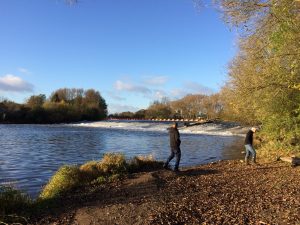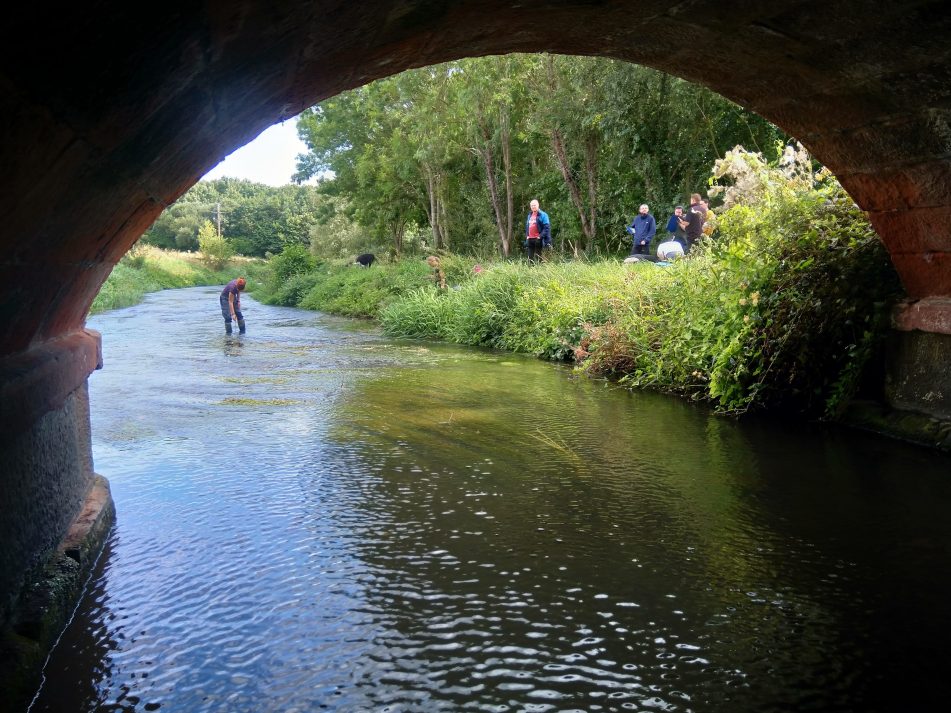
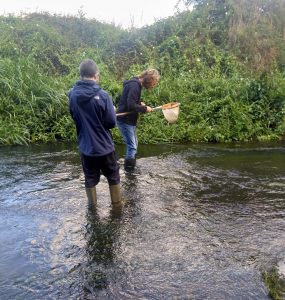
Colleagues collecting a sample during a Field Studies Council course in Shropshire
My name is Pete, and I work for the project in the role of Waterways Environment Apprentice. For the duration of my apprenticeship I am assisting with the delivery of volunteer work parties, as well as learning about the habitats and management of our waterways.
Before I started my role here, I attended a 5 day “Wildlife Surveying and Monitoring” course with the Field Studies Council, which covered freshwater invertebrates. There I learned about how monitoring the different species of invertebrates can indicate the health of a river. We took two samples, a few miles away from each other, of the same river in Shropshire and got totally different results. This really intrigued me, and I wanted to learn more. When it came to identifying the species though I was in for a surprise. There are thousands of species of freshwater invertebrates in the UK and many you need a microscope to identify. I came away feeling a bit bemused. How was I going to ID what I catch?
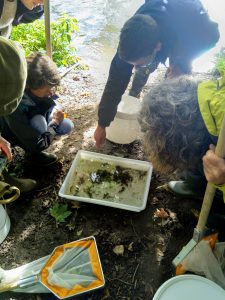
A healthy sample from a river in Shrewsbury
In the first few weeks of my new role working for the Unlocking the Severn project I attended some riverfly training sessions hosted by Lisa Barlow of the Severn Rivers Trust. It’s an easy system of kick-sampling the sediment in a small stretch of stream and moving your net around the marginal weeds and reed. You time your sample, and after 3 minutes you empty the contents of your net into a white tray. You can choose to count the sample on the riverbank or take it home where you may feel more comfortable. There’s always a sense of excitement when you first empty your sample into your tray. You’re provided with a kit which includes a simple ID guide, and you’re required to identify just 8 family groups.
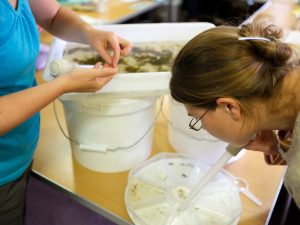
Riverfly volunteers splitting their sample into the 8 family groups
You’re supplied with a segmented tray with 8 sections, (it looks a bit like a sauce tray used for dipping nachos in!) and you’re able to split your family groups up into the sections of the white tray, making them easier to count if you have a healthy sample. Recording the data on the Riverfly Partnership website is easy.
Monthly surveys of the same stretch of river will regularly monitor the invertebrate numbers. Anomalies in the data triggers a warning of possible pollution. If your sample is worryingly lower than your average sample this could mean there’s a problem upstream, and the relevant authorities could be notified, and the stretch of river in question can be further investigated.
You may be wondering what this has to do with our project. We are building fish passes on the River Severn, so why does counting tiny invertebrates way upstream matter? Well this is a river connectivity project. We are committing to reconnecting people to the river. Our project shares the beliefs of The Canal & River Trust and the Severn Rivers Trust…. Encourage people outdoors to promote wellbeing, and there’s an enormous feeling of satisfaction knowing that you’re helping the health of our rivers. It’s also about keeping the rivers in a healthy state. What good is building fish passes if there’s no food in the river for the fish to eat?
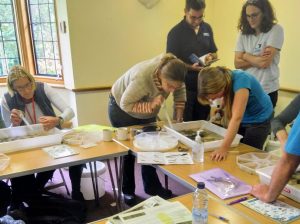
Identifying invertebrates using the Riverfly ID guide
Rivers are a sensitive habitat. I learned recently that Pearl Mussels live in streams like the River Teme (a tributary of the Severn). They lay their eggs and they get washed downstream. How do the microscopic larvae find their way back upstream? They hitch a ride! When fish like Salmon or Trout attempt to feed on these larvae they attach themselves to the host fish’s gills until the fish has made its way upstream and ready to spawn. The larvae then falls off in the more favourable, cleaner waters upstream and grows to become an adult Pearl Mussel. Pearl Mussels can live for over 100 years, and their numbers are in decline. Could it be that by helping big fish like Trout and Salmon migrate upstream, we’ll also be helping invertebrate numbers?
I’ve got my kit and I’ll be making monthly trips to my local river in Cheltenham. If you’re interested in doing some free Riverfly training please contact the Riverfly Partnership by visiting their website: http://www.riverflies.org/


